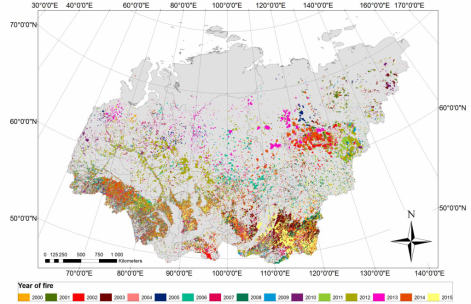Satellite images can be used to estimate forest recovery after fire
21 August 2019 г.

About ten million hectares of forest burn every year in Russia. Most often fires occur in Siberia. One of the highest levels of fire activity is observed in the Zabaykalsk region. Natural recovery of forest stands takes long periods of time and depends on the type of the fire-damaged forest, type of fire and its intensity, as well as on its area, climate conditions, properties of soils, humidity and on many other factors. Each area has its peculiarities which influence the duration of forest recovery after fire.
A group of scientists working at several research organizations fr om the Great Britain and Krasnoyarsk, including the Sukachev Institute of Forest KSC SB RAS used the data of Earth remote sensing to determine the progress in forest recovery in the areas damaged by fire. The scientists carried out monitoring of the areas of the Zabaykalsk region affected by fire and demonstrated the possibility to observe and predict the recovery processes using the satellite data. Forest recovery was shown to take tens of years. The results also demonstrated the forest recovery in the Zabaykalsk regions to be mostly hindered by dry climate conditions.
The scientists analyzed a number of factors to understand their influence on the success in forest recovery. The research took into account the fire intensity, state of the forest stand before the fire outbreak, topography, temperature anomalies of the soil surface. The researchers noticed that it was the high frequency of fires and elevated ground temperatures which mostly hindered the recovery. The higher was degree of forest damage by fire, the longer the recovery.
To estimate the degree of fire impact on the forests and to control their development after fire, use was made of remote sensing data and ground based observations. Using the satellite images the scientists determined the area of the forests damaged by fire. In the sampling areas, the scientists determined the height, age and state of young trees.
The successful recovery of Zabaykalsk forest was shown to be hindered by several factors. First, the soil temperature in the fire sites is as high as sixty degrees, which results in a low survival rate of young trees, thermal stress and drying. The amount of understory is not sufficient for successful forest recovery on dry soils. Due to the lack of humidity and nutrients, there is strong competition among the plants. Grasses also hinder the growth of young trees. Grasses grow intensively in the burned areas which creates much turf. Besides, after big fire outbreaks there are hardly any seeds in the soil. A conclusion can be made that fires result in decreased forest regeneration due to the burning of organic matter on the soil surface, its depletion, drying and growth of grass.
Another problem for forest recovery in the Zabaykalsk region is in the repeated fires. Even if new seedlings appear, they can again die in fire. Repeated fires often result in the complete death of trees and transformation of forests into steppes.
«In the Zabaykalsk region the frequency of fires is very high, the same area can burn twice a year. This is a unique region, it is very dry, there is little precipitation in winter, the soil is not moistened by snow. This results in strong fires. Using the satellite data we estimated the progress in forest recovery and factors which determine this process. Subsequently, it will be possible to forecast forest recovery in particular areas», – explains Yelena Kukavskaya, Candidate of Biological Sciences, senior research associate of the Laboratory of Forest Pyrology at the Sukachev Institute of Forest, SB RAS.
The researcher also says that planting trees can aid in forest recovery. In the south of the Zabaykalsk region wh ere soil overheating is possible, shading can increase the survival of seedlings. At the same time stronger measures must be taken for fire prevention including fire-fighting public awareness, firebreaks, fire lines, especially, near settlements.
The research was supported by the Russian Foundation for Basic Research and Natural Environment Research Council, Great Britain.
Share:
